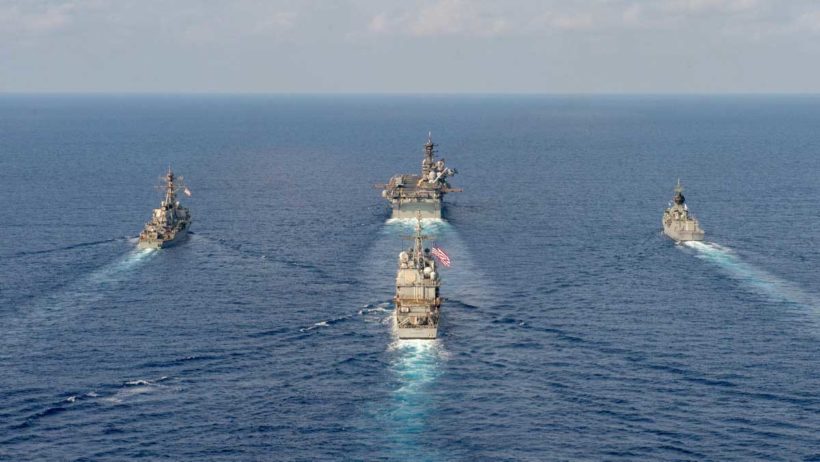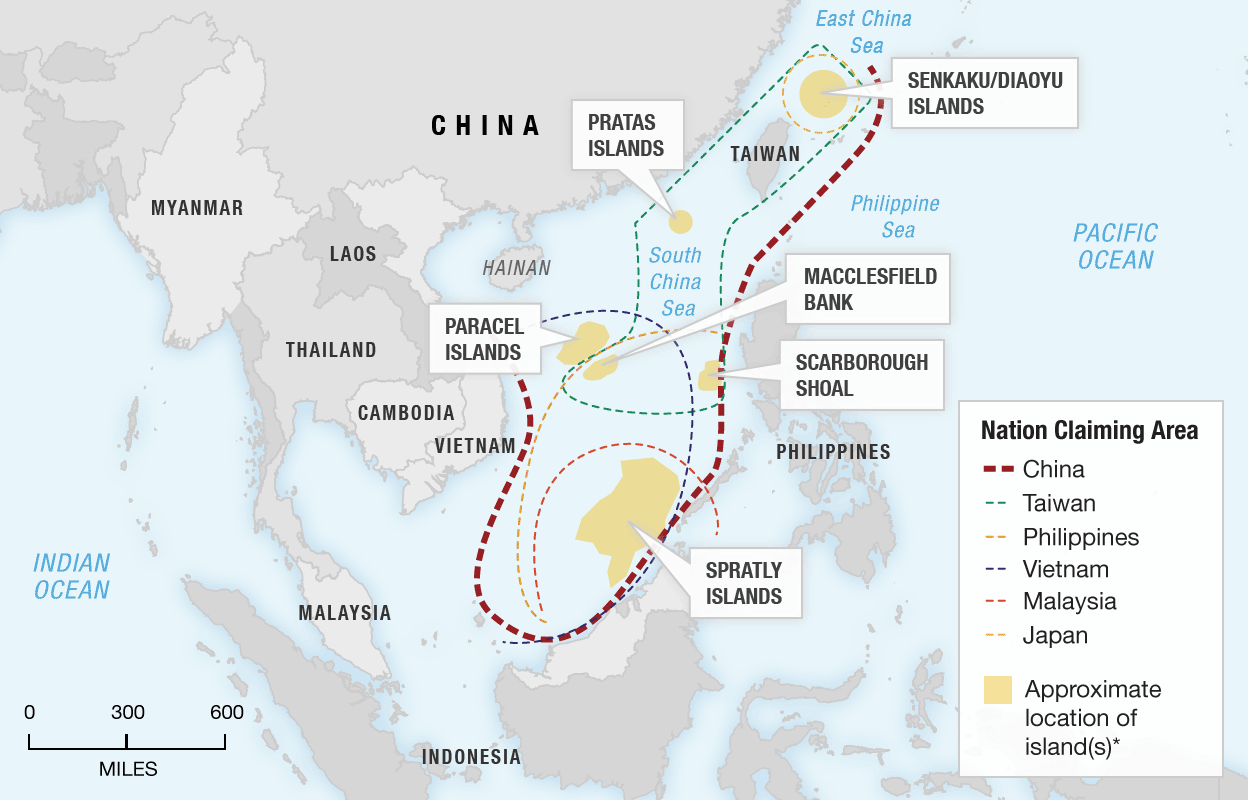
USS America (top center), USS Barry (top left) and USS Bunker Hill (rear) conduct office of the watch maneuvers in the South China Sea with Royal Australian Navy helicopter frigate HMAS Parramatta (top right), April 2020.
redo Jump to...
print Print...
(by Sam LaGrone, USNI News and Susan Katz Keating, JustTheNews) — Guided-missile cruiser USS Bunker Hill conducted a freedom of navigation operation through the Spratly Island chain in the South China Sea, U.S. 7th Fleet announced on Wednesday.
According to a statement from the Navy, the cruiser tested excessive maritime claims by China, Vietnam and Taiwan. All three countries have overlapping claims in the contested island chain.
Bunker Hill, without prior notification, conducted an innocent passage past an unspecified feature in the Spratly chain. Under international maritime law, a warship can move through a country’s territorial sea without notification as long as it doesn’t conduct any military operations.
“Unlawful and sweeping maritime claims in the South China Sea pose a serious threat to the freedom of the seas, including the freedoms of navigation and overflight and the right of innocent passage of all ships,” reads the statement from 7th Fleet.
“This freedom of navigation operation upheld the rights, freedoms, and lawful uses of the sea recognized in international law by challenging the restrictions on innocent passage imposed by China, Vietnam and Taiwan.”
A Navy official told USNI News the transit was in the vicinity of Gaven Reef, home to [an unlawful] Chinese military supply installation. Under international maritime law, the feature commands its own territorial sea that would require a warship to make an innocent passage within 12 nautical miles without prior notification.
The Bunker Hill FONOP [Freedom of Navigation Operation] follows a Tuesday operation in which guided-missile destroyer USS Barry tested Chinese and Vietnamese claims in the Paracel Islands, also in the South China Sea.
Beijing on Tuesday claimed that the USS Barry violated Chinese sovereignty and security, and that its actions in some way were “incompatible” with international efforts to contain COVID-19.
“China urges the United States to focus on its own business with pandemic prevention and control, make more contributions to the global fight against the COVID-19, and immediately stop military operations that are detrimental to regional security, peace and stability,” said Senior Colonel Li Huamin in a statement.
The Communist PLA (People’s Liberation Army) of China claimed to have sent ships and aircraft to warn off the USS Barry, but did not publish photographs to document the claims.
The USS Barry has been deployed to the U.S. 7th Fleet area of operations throughout the Indo-Pacific region, according to the U.S. Navy.
Agence France-Presse reported on April 29: Last week China sought to further advance its territorial claims when it announced that the Paracel and nearby Spratly Islands, the Macclesfield Bank and their surrounding waters would be administered under two new districts of Sansha city, which China created on nearby Woody Island in 2012. The communist government also announced official Chinese names for 80 islands and other geographical features in the South China Sea, including reefs, seamounts, shoals and ridges, 55 of them submerged in water.
Compiled from reports published at USNI .org (U.S. Naval Institute News) on April 29 and justthenews .com on April 28. Reprinted here for educational purposes only. May not be reproduced on other websites without permission.
Questions
NOTE: Before answering the questions, read “Background” below the questions.
1. The first paragraph of a news article should answer the questions who, what, where and when. List the who, what, where and when of this news item. (NOTE: The remainder of a news article provides details on the why and/or how.)
2. What is freedom of navigation?
3. What was the purpose of USS Bunker Hill’s freedom of navigation operation? Be specific.
4. Why could our ship conduct an innocent passage in the South China Sea without prior notification to the countries that claiming the area?
5. Consider the map and check previous articles under “Resources” on China’s actions in the South China Sea.
The U.S. 7th Fleet confirmed in an April 29 statement:
“The international community has an enduring role in preserving the freedom of the seas, which is critical to global security, stability, and prosperity.
As long as some countries continue to claim and assert limits on rights that exceed what is provided for under international law as reflected in the Law of the Sea Convention, the United States will continue to demonstrate its resolve to uphold these rights and freedoms for all.”
“No member of the international community should be intimidated or coerced into giving up their rights and freedoms.”
a) How are you heartened by U.S. resolve and leadership as confirmed by the U.S. 7th Fleet’s statement?
b) How important do you think it is to these countries that the U.S. asserts our commitment to freedom for all in challenge to China’s attempt at unlawful claims in the South China Sea?
Background
The United Nations Convention on the Law of the Sea [UNCLOS] establishes rules governing all uses of the oceans and their resources. The Law of the Sea is the international agreement that defines the rights and responsibilities of nations with respect to their use of the world’s oceans. Although the United States has not ratified UNCLOS, it adheres to many of its provisions.
Innocent passage – according to UN Convention on the Law of the Sea allows naval ships to transit another nation’s territorial waters without prior notice if they don’t conduct threatening activity. Providing notice or obtaining permission prior to transiting under innocent passage is not required.
Freedom of Navigation Operations are operations by U.S. naval and air forces that reinforce internationally-recognized rights and freedoms by challenging excessive maritime claims. Excessive maritime claims are assertions by states that are inconsistent with the terms of of the UN Law of the Sea. In other words, they are unlawful or illegal. The particulars of each freedom of navigation operation are determined by the excessive maritime claim that is being protested.
- From Harvard: “Freedom of Navigation in the South China Sea: A Practical Guide” – includes maps
- From the conservative Heritage Fdn: “7 Reasons U.S. Should Not Ratify UN Convention on the Law of the Sea“
What is the South China Sea? (from Australia’s New Daily)
- The South China Sea is a critical commercial gateway for a large portion of the world’s merchant shipping.
- It is bordered by Brunei, Cambodia, China, Indonesia, Malaysia, the Philippines, Singapore, Taiwan, Thailand and Vietnam.
- China claims almost all of the strategic South China Sea with Brunei, Indonesia, Malaysia, the Philippines, Taiwan and Vietnam pushing competing claims to parts of the maritime region.
- China has been militarizing the region for several years now. In 2018, China placed anti-ship cruise missiles and long-range surface-to-air missiles on the contested Spratly Islands, according to a recent Pentagon report.
- The US, Japan and India do not have any territorial claims there.
- For more information on the South China Sea and its geo-political importance, the Lowy Institute has an excellent overview. (includes map)
Resources
Go to amti.csis.org for interactive maps of Asia Pacific.
For previous articles on the U.S., China and the South China Sea:
- U.S., Japan, India and Philippines challenge Beijing with naval drills (May 10, 2019)
- Japan challenges China with sub exercise in South China Sea (Sept. 18, 2018)
- China’s claims to the South China Sea stretch roughly 1,000 miles from its southern shores, pitting it against Taiwan, the Philippines, Brunei, Malaysia, and Vietnam (March 6, 2018)
- China continues South China Sea buildup (Dec. 19, 2017)
- US Navy aircraft carrier arrives in Vietnam (March 2018)
- U.S. Warship Sails Near Island Claimed by China (Feb. 2016)
- Angry China shadows U.S. warship near man-made islands (Oct. 2015)
Daily “Answers” emails are provided for Daily News Articles, Tuesday’s World Events and Friday’s News Quiz.




